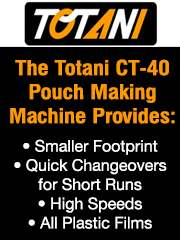UV and EB: Making the Trek into Energy Curing
- Published: May 01, 2001, By Teresa Koltzenburg, Senior Editor
Electron beam accelerator, electrodeless microwave ultraviolet bulbs… Neither of these exotic-sounding expressions figured in a conversation between Captain Kirk and Scottie or Jean Luc Picard and Jordy (though either one certainly sounds as if it could). But all three are part of the “energy curing” language that soon may become part of your operation's vernacular — as you contemplate and/or enter the radiation curing frontier.
A process with so many sci-fi-sounding expressions has to be complicated and expensive, right? “Wrong,” says Mark Tausch, project engineer at UV Technology, Cincinnati, OH. “It seems like it's quite complicated, but if you take the time to learn about it, you find it's really very simple technology.”
Rick Sanders, sales/marketing executive for Energy Sciences Inc., Wilmington, MA, agrees. “The chemistries reactive to electron beam and ultraviolet light are simply changing the molecular structure from a liquid to a solid, so there's no evaporation. That's why the chemistry is referred to as ‘100 percent solid.’ At the beginning, it's difficult for a lot of people to understand.”
Rick Fisher, business development manager — converting, Fusion UV Systems, Gaithersburg, MD, explains that part of his company's mission is to help converters do just that. “We [educate] the customers and the OEMs in order to make them more comfortable with the technology.”
Fisher adds, while UV might seem high-tech, futuristic, and difficult, the reality is many converters have been utilizing and benefiting from its environmentally friendly status and high operating efficiencies. “UV has been used for a number of years, for example, in silicone-release coatings on film substrates and even on some paper. Of course, there are a lot of people that haven't gotten into it yet, but there are companies that have been in it for a decade or so. Also, there are pressure-sensitive-type activities that have been going on for several years, and still, that's one of the newer areas.”
So why aren't more converters exploring the world of faster web speeds and the environmental advantages available with UV or EB curing?
Tausch thinks it's the perception that curing technology is too expensive. “Perceived cost of equipment and the ancillary things such as inks make people wary. But if you look at it from just the initial-cost standpoint, and you don't consider the energy savings, the faster throughput, the quicker makereadies, and changeover times, it looks as if ultraviolet isn't a viable way to print. Yet, there are significant benefits to be had by using it.”
Tausch, Sanders, and Fisher all reeled off what seemed to be an inexhaustive list of radiation curing advantages in printing (and coating) with UV- or EB-curable materials: faster web speeds; dot gain savings; superior print quality; environmental benefits; the ability to ship product right off the press due to instant cure; long-term energy savings; easier machine clean-up; and more.
So, if yours isn't an operation that's forged into the radiation curing frontier, it could be time to boldly go where you haven't gone before. A couple of tips for your voyage: Tausch says there's a bit of a terminology misunderstanding: “If you were a chemist, and I were to say ‘radiation curing’ to you, you would think of electron beam curing. A chemist will differentiate between photo-chemical curing — or ultraviolet — and radiation — electron beam — curing because of the different ways the energy is used; the EB technology utilizes electrons; in UV we use photons.”
In addition, all three suppliers say “energy” curing is becoming more affordable. But don't be caught off guard when you get into the numbers. “On the EB side of things,” says Sanders, “we're still making the beam smaller in size, and we're still trying to get an associated reasonable price tag. We've asked converters across North America, ‘What do you need?’ In listening to what those folks have said, we've come back to our engineers with, ‘Okay, you've got to reinvent the wheel, because the wheel is too big, too bulky, and too much money.’ Ultimately, I'd like to see if we can get an EB system that's actually going to be cheaper than UV. We're certainly moving in the right direction, but we're not done.”
No exploration ever is.












